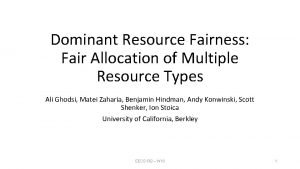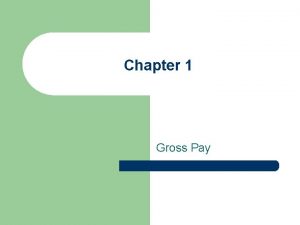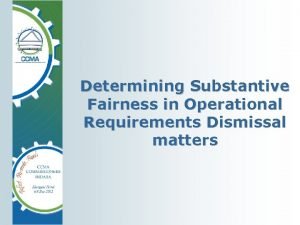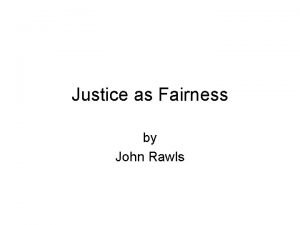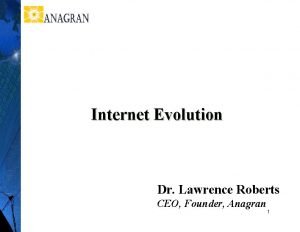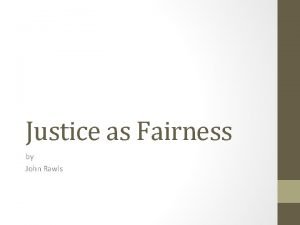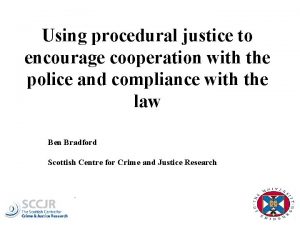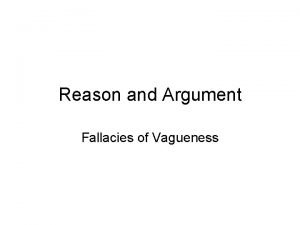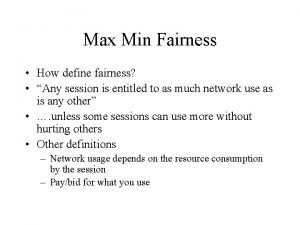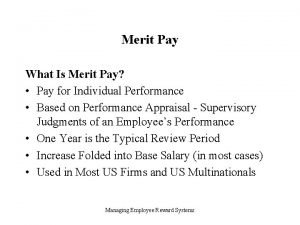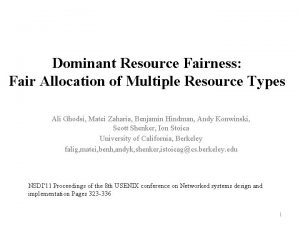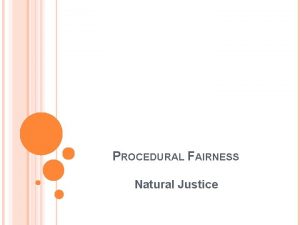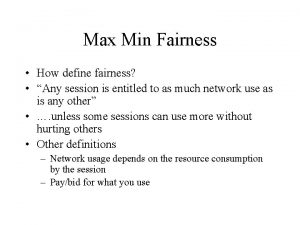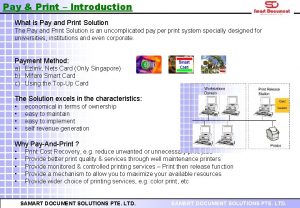LongTerm Resource Fairness Towards Economic Fairness on Pay































- Slides: 31

Long-Term Resource Fairness Towards Economic Fairness on Pay -as-you-use Computing Systems Shanjiang Tang, Bu-Sung Lee, Bingsheng He, Haikun Liu School of Computer Engineering Nanyang Technological University

Pay-As-You-Use is Pervasive • Charge users based on the amount of resources used over time (e. g. , Hourly). • Advantages – Elasticity – Flexibility – Cost efficiency • Pay-as-you-use is becoming common and popular. – Supercomputing, Cloud Computing 2

Resource Utilization = • User resource demands are heterogeneous. – Users have different demands. – A user’s demand is changing over time. Static provisioning/partitioning causes underutilization. • Resource utilization is a critical problem in such pay -as-you-use environments. – Providers waste resources ( waste investment and lose profit). – Users waste money. Twitter’s Cluster 3 One week data from Twitter production cluster [Delimitrou et. Al. ASPLOS’ 14]

To Share or Not To Share? • Resource Sharing can improve resource utilization. – Allow underloaded users to release resources to other users. – Allow overloaded users to temporarily use more resources (from others). Reduce the idle resources at runtime. Resolve resource contention across users. • What about fairness? – If the fairness is not solved, resource sharing is unlikely to achieve in pay-as-you-use environments. 4

Pay-as-you-use Fairness: Resource-as-you-pay • The total resources a user gained should be proportional to her payment. • This is a Service-Level Agreement (SLA). A: 60 $ A 60% B: 40 $ B 40% Resource Service = Resources-per-time X service time 5

Fair Policy in Existing Systems • State-of-the-art: Max-min fairness – Select the user with the minimum allocation/share ratio every time. – Consider the present requirement only (memoryless). • Memoryless fairness has severe problems in pay-as-you-use environments, violating the following properties: – Resource-as-you-pay fairness guarantee. – Non-Trivial workload incentive and sharing incentive. – Truthfulness (Users may get benefits by cheating). 8

Problems with Memory. Less Fairness • Resource-as-you-pay Fairness Problem – E. g. , A, B equally pay for total resource of 100 units. New Demand 20 Time Current Allocation at t 1: t 1 A B 20 100 80 Accumulate Resource Usage: Unsatisfied Demand 20 80 0 20 A B 9

Problems with Memory. Less Fairness • Resource-as-you-pay Fairness Problem – E. g. , A, B equally pay for total resource of 100 units. New Demand Time 40 Current Allocation at t 2: A B t 1 20 100 t 2 40 60 60 Accumulate Resource Usage: Unsatisfied Demand 60 140 0 20 A B 10

Problems with Memory. Less Fairness • Resource-as-you-pay Fairness Problem – E. g. , A, B equally pay for total resource of 100 units. New Demand Time 50 Current Allocation at t 3: 50 A B t 1 20 100 t 2 40 60 t 3 80 50 Unsatisfied Demand Accumulated resource usage: 110 190 30 20 A B 11

Problems with Memory. Less Fairness • Resource-as-you-pay Fairness Problem – E. g. , A, B equally pay for total resource of 100 units. New Demand Time 50 Current Allocation at t 4: 50 A B t 1 20 100 t 2 40 60 t 3 80 50 t 4 60 50 Unsatisfied Demand Accumulated resource usage: 160 240 40 20 A B Existing Fair Policy fails to satisfy Resource-as-you-pay fairness!!! 12

Memory. Less Fairness Violates Sharing Incentives • Non-trivial workload and sharing incentive Problem – Yielding resources to others have no benefits. – Suppose A, B, and C equally pay for total resource of 100 units. A has 13 idle resource units. In that case, A can be selfish, either idle or running trivial workloads. CPU A: 20 13 B: 33 C: 33 A’s idle resource 13

Cheating User Benefits on Memory. Less Fairness • Truthfulness Problem – Suppose A, B, C equally pay for a cluster of 100 units, with true demand to be 33, 21 and 80, respectively. – Case 1: all are honest. – Case 2: User A cheats and claims the demand to be 40. A: 33 A: B: 21 12 B: 33 C: Case 1: A is honest 33 6 21 6 A’s cheating get benefits 33 Case 2: A is cheating 14

Our Work • Challenges: can we find a fair sharing policy that satisfies the following properties? – Resource-as-you-pay fairness – Non-trivial workload and sharing incentives – Truthfulness • Our Solution: Long-Term Resource Fairness – Ensure resource fairness over a period of time. – With historical information considered. 15

Long-Term Resource Fairness • Basic Concept: Loan agreement (Lending w/o interests) – When resources are not needed, users can lend the resources to others. – When more resources are needed, others should give back. Benefit others and user herself. 16

Long-Term Resource Fairness • Satisfy Pay-as-you-use Fairness 20 Current Allocation at t 1: 80 Lend Resources: A 30 B -30 New Demand Time t 1 A B 20 100 Unsatisfied Demand Accumulated resource usage: 20 80 0 20 A B 17

Long-Term Resource Fairness • Satisfy Pay-as-you-use Fairness Lend Resources: 40 Current Allocation at t 2: 60 A B 40 New Demand Time A B t 1 20 100 t 2 40 60 -40 Unsatisfied Demand Accumulated resource usage: 60 140 0 20 A B 18

Long-Term Resource Fairness • Satisfy Pay-as-you-use Fairness Lend Resources: 40 Current Allocation at t 2: 60 A B 40 -40 New Demand Time A B t 1 20 100 t 2 40 60 t 3 80 50 Unsatisfied Demand Accumulated resource usage: 60 140 0 20 A B 19

Long-Term Resource Fairness • Satisfy Pay-as-you-use Fairness Lend Resources: Current Allocation at t 3: 80 A B 10 -10 New Demand Time A B t 1 20 100 t 2 40 60 t 3 80 50 20 Unsatisfied Demand Accumulated resource usage: 140 160 0 50 A B 20

Long-Term Resource Fairness • Satisfy Pay-as-you-use Fairness Lend Resources: Current Allocation at t 3: 80 A B 20 10 -10 New Demand Time A B t 1 20 100 t 2 40 60 t 3 80 50 t 4 60 50 Unsatisfied Demand Accumulated resource usage: 140 160 0 50 A B 21

Long-Term Resource Fairness • Satisfy Pay-as-you-use Fairness Lend Resources: Current Allocation at t 4: 60 40 A B 0 0 New Demand Time A B t 1 20 100 t 2 40 60 t 3 80 50 t 4 60 50 Unsatisfied Demand Accumulated resource usage: 200 0 60 A B Long-Term Resource Fairness satisfy Resource-as-you-pay fairness. 22

Other Properties of Long-Term Resource Fairness • Satisfy non-trivial workload and sharing incentives – Running trivial workload can waste money. – Not sharing idle resource can waste money. • Users cannot get benefits by lying (strategy proof). Proof sketches are in the paper. 23

LTYARN • Implement Long-Term Resource Fairness in YARN – Extend memoryless max-min fairness to long-term maxmin fairness. – Add a few components into resource manager • Support full long-term and time window-based requirements. • Currently support a single resource type (main memory). 24

LTYARN Design • Quantum Updater (QU) – Estimates task execution time. – Updates the resource usage history periodically. • Resource Controller (RC) – Manages and updates resource for each queue. • Resource Allocator (RA) – Performs long-term resource allocation. – Runs when there are pending tasks and idle resources. 25

Evaluation • A Hadoop Cluster – 10 nodes, each with two Intel X 5675 CPUs (6 cores per CPU with 3. 07 GHz), 24 GB DDR 3 memory, 56 GB hard disks. – YARN-2. 2. 0, configured with 24 GB memory per node. • Macro-benchmarks – – Synthetic Facebook Workload Purdue Workload HIVE/TPC-H Spark Detailed setups are in the paper. 26

Metrics • Evaluation metrics – Fairness degree for each user (>1 for sharing benefits; <1 for sharing loss) – Resource-as-you-pay fairness – Application performance • Benchmark scenario – The four macro benchmarks equally share the cluster. – Each benchmark runs in a separate queue. – Window size =1 day. 27

Sharing Benefit/Loss • LTYARN enables sharing benefits for all applications. (a). YARN (b). LTYARN 29

Resource-as-you-pay Fairness Results • LTYARN achieves resource-as-you-pay fairness. 30

Performance Results • Sharing always achieves a better performance. • Long-term fairness is comparable to memory-less fairness (max-min). 31

Conclusions • Max-min resource fairness is memoryless and unsuitable for pay-as-you-use computing. • We define long-term resource fairness that can satisfy the desirable properties. • We develop LTYARN by integrating long-term resource fairness into YARN – Homepage: http: //sourceforge. net/projects/ltyarn/ 32

We are Hosting IEEE Cloud. Com 2014 in Singapore • Deadline for paper submissions: July 31, 2014 • Notification of Paper acceptance: September 2, 2014 • Conference: December 15 -18, 2014 34

Thanks! Question? 35
 Dominant resource fairness
Dominant resource fairness York will end longterm solitary jails
York will end longterm solitary jails Kernel longterm
Kernel longterm Section 1-1 hourly pay answers
Section 1-1 hourly pay answers How much did wanda pay in taxes this pay period?
How much did wanda pay in taxes this pay period? Designing pay levels mix and pay structures
Designing pay levels mix and pay structures Demotivators and edward deci theory
Demotivators and edward deci theory Resource leveling is the approach to even out the peaks of
Resource leveling is the approach to even out the peaks of Contoh resource loading
Contoh resource loading Regulatory & economic resource
Regulatory & economic resource Economic growth vs economic development
Economic growth vs economic development Economic development vs economic growth
Economic development vs economic growth Chapter 1 lesson 2 our economic choices worksheet answers
Chapter 1 lesson 2 our economic choices worksheet answers Substantive fairness
Substantive fairness The fairness doctrine
The fairness doctrine Veil of ignorance meaning
Veil of ignorance meaning Fairness and flawless ceo
Fairness and flawless ceo Fairness
Fairness Fairness and development global context
Fairness and development global context Fairness adjective
Fairness adjective The fairness doctrine
The fairness doctrine Avoiding discrimination through causal reasoning
Avoiding discrimination through causal reasoning Veil of ignorance example
Veil of ignorance example Keva fairness cream
Keva fairness cream Fairness scenarios
Fairness scenarios Procedural justice
Procedural justice Line-drawing fallacy
Line-drawing fallacy Max-min fairness
Max-min fairness Fairness and diversity in the workplace
Fairness and diversity in the workplace Fairness
Fairness Max-min fairness example
Max-min fairness example Towards deep conversational recommendations
Towards deep conversational recommendations
